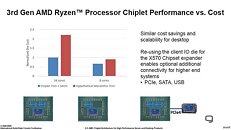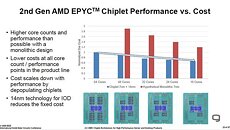Thursday, February 27th 2020

AMD Gives Itself Massive Cost-cutting Headroom with the Chiplet Design
At its 2020 IEEE ISSCC keynote, AMD presented two slides that detail the extent of cost savings yielded by its bold decision to embrace the MCM (multi-chip module) approach to not just its enterprise and HEDT processors, but also its mainstream desktop ones. By confining only those components that tangibly benefit from cutting-edge silicon fabrication processes, namely the CPU cores, while letting other components sit on relatively inexpensive 12 nm, AMD is able to maximize its 7 nm foundry allocation, by making it produce small 8-core CCDs (CPU complex dies), which add up to AMD's target core-counts. With this approach, AMD is able to cram up to 16 cores onto its AM4 desktop socket using two chiplets, and up to 64 cores using eight chiplets on its SP3r3 and sTRX4 sockets.
In the slides below, AMD compares the cost of its current 7 nm + 12 nm MCM approach to a hypothetical monolithic die it would have had to build on 7 nm (including the I/O components). The slides suggest that the cost of a single-chiplet "Matisse" MCM (eg: Ryzen 7 3700X) is about 40% less than that of the double-chiplet "Matisse" (eg: Ryzen 9 3950X). Had AMD opted to build a monolithic 7 nm die that had 8 cores and all the I/O components of the I/O die, such a die would cost roughly 50% more than the current 1x CCD + IOD solution. On the other hand, a monolithic 7 nm die with 16 cores and I/O components would cost 125% more. AMD hence enjoys a massive headroom for cost-cutting. Prices of the flagship 3950X can be close to halved (from its current $749 MSRP), and AMD can turn up the heat on Intel's upcoming Core i9-10900K by significantly lowering price of its 12-core 3900X from its current $499 MSRP. The company will also enjoy more price-cutting headroom for its 6-core Ryzen 5 SKUs than it did with previous-generation Ryzen 5 parts based on monolithic dies.
Source:
Guru3D
In the slides below, AMD compares the cost of its current 7 nm + 12 nm MCM approach to a hypothetical monolithic die it would have had to build on 7 nm (including the I/O components). The slides suggest that the cost of a single-chiplet "Matisse" MCM (eg: Ryzen 7 3700X) is about 40% less than that of the double-chiplet "Matisse" (eg: Ryzen 9 3950X). Had AMD opted to build a monolithic 7 nm die that had 8 cores and all the I/O components of the I/O die, such a die would cost roughly 50% more than the current 1x CCD + IOD solution. On the other hand, a monolithic 7 nm die with 16 cores and I/O components would cost 125% more. AMD hence enjoys a massive headroom for cost-cutting. Prices of the flagship 3950X can be close to halved (from its current $749 MSRP), and AMD can turn up the heat on Intel's upcoming Core i9-10900K by significantly lowering price of its 12-core 3900X from its current $499 MSRP. The company will also enjoy more price-cutting headroom for its 6-core Ryzen 5 SKUs than it did with previous-generation Ryzen 5 parts based on monolithic dies.


89 Comments on AMD Gives Itself Massive Cost-cutting Headroom with the Chiplet Design
AMD EPYC™ 7742 @225W vs Intel® Xeon® Platinum 9282 @400W
There's your shrink. I wonder if the desktop ones will be exactly the same or be different from the mobile editions.
When has a new Generation cpu ever been cheaper than previous gen?
In your previous post you said the APU is larger, I said it's smaller, there's a link to a pic in this thread.A shrink and a compromise. The first two generations of Ryzen APU's have used the same die for both mobile and desktop.
I should have clarified an all 7nm monolithic Zen 2 CPU design would be smaller than a monolithic Zen 2 APU.
The previous gens were based on Zen and Zen+ that were monolithic to begin with too.
I really hope AMD doesn't kill PCIe 4.0 on the desktop APUs then. One point is that a monolithic die can use less cache to get similar or better performance as you don't need the big caches to offset the latency hit of chiplets.
I'm really curious to see the memory benchmarks of the Zen 2 APUs. Does it have full speed memory read and writes and the latency.
I wants APU not CPU... Heh
It seems to be using too much power, and can run very hot.
Or does mobile Ryzen 4000 have PCIe 4?